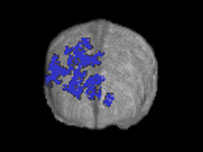The Basic Scientific Evidence of Acupuncture
- Scan showing area of the brain deactivated by acupuncture
There have been numerous surveys shown that, of all the complementary medical systems, acupuncture enjoys the most credibility in the medical community. Evidence from Randomized Controlled Trial research is probably not the main basis for this positive opinion. A more likely reason is the existence of a substantial body of data showing that acupuncture in the laboratory has measurable and replicable physiologic effects that can offer plausible mechanisms for the presumed actions. Extensive research has shown that acupuncture analgesia may be initiated by stimulation in the muscles of high-threshold, small-diameter nerves. These nerves are able to send messages to the spinal cord and then activate the spinal cord, brainstem (periaqueductal gray area), and hypothalamic (arcuate) neurons, that, in turn, trigger endogenous opioid mechanisms.

Functional magnetic resonance imaging is also beginning to demonstrate that acupuncture has regionally specific, quantifiable effects on relevant structures of the human brain. One study found that a specific acupuncture point, traditionally related to vision, activated an occipital lobe region that was the same area activated by stimulation of the eye using direct light. The point was located on the lateral aspect of the foot; stimulation of nearby sham points did not result in similar activation. Other studies show that specific acupuncture points, but not controls, activate structures of descending antinociceptive pathways and deactivate multiple limbic areas that participate in pain processing.
These functional magnetic resonance imaging studies follow earlier efforts showing that electro-acupuncture results in significantly increased concentrations of neuropeptide Y, neurokinin A, and substance P in the rat brain (specifically, the occipital cortex and hippocampus).
Another study, carried out on a set of volunteers by scientists at Hull York Medical School, England in 2005, showed a measurable brain MRI evidence of that an acupuncture technique using deep needling led to the deactivaton of part of the brain's limbic system, which helps the body to be conscious of pain.